Ever since Tokaido aired on TableTop back in 2014 it was a game that I really wanted to try. In addition to looking really fun on TableTop, Tokaido is really well liked currently standing at around the 400th best board game of all time on Board Game Geek. In Tokaido you play as a traveler who is following the prestigious Tokaido path in Japan hoping to create the most satisfying journey. What initially interested me about Tokaido was the game’s interesting theme, amazing artwork and interesting mechanics. Tokaido might not be quite perfect but it is a relaxing and enjoyable journey that most people will have a blast playing.
How to Play Tokaido
Setup
- Set the gameboard in the middle of the table.
- Take the achievement cards and place them next to the board.
- Separate the cards into piles based on the backs of the cards. Shuffle the meal, souvenir, encounter, and hot spring piles and place them on the corresponding spots on the gameboard.
- Sort the panorama cards by type and then sort each type placing the lowest numbered cards on top. Place each set of panorama cards on their corresponding spot on the gameboard.
- Place the coins next to the gameboard.
- Each player chooses a color and takes the corresponding marker, traveler piece and token. Place the marker on the 0 space of the scoring track.
- Each player randomly draws two traveler tiles. Each player will choose which of the two travelers they are going to play as. Each traveler provides their own special ability to the player.
- Hiroshige the artist: When you arrive at the three intermediate inns, take one panorama card of your choice and score the corresponding points.
- Chuubei the messenger: When you arrive at the three intermediate inns, the player gets to draw one encounter card and apply its effect. This happens before the meal.
- Kinko the ronin: All meal cards purchased cost one less coin making one coin meals free.
- Yoshiyasu the functionary: When drawing encounter cards the player gets to draw two encounter cards. The player gets to choose which one they want to keep and the other card is placed on the bottom of the pile.
- Satsuki the orphan: When the player arrives at the inn they will take the top meal card from the pile and will receive it for free. Instead of this card the player could choose to purchase a meal like normal.
- Mitsukuni the old man: The player will receive one additional victory point for each hot springs and achievement card received during the game.
- Sasayakko the geisha: If the player buys a souvenir card they can take another souvenir of the same price or cheaper for free.
- Hirotada the priest: When visiting the temple the player can take one coin from the bank and donate it under their name. The player can still donate up to three of their own coins.
- Umegae the street entertainer: The player receives one point and one coin for each encounter space they land on. These are received before they draw an encounter card.
- Zen-emon the merchant: When visiting a village you can purchase one souvenir card for one coin instead of the price shown on the card.
- Each player places their color token inside their traveler tile. Each player will receive coins based on the number in the top right corner of their traveler tile.
- Randomly place the traveler pieces on the start space. The player whose traveler piece was placed on the space furthest from the first inn will start the game.
Playing the Game
In Tokaido the next player is determined by whose playing piece is furthest back on the path. If a player moves and is still furthest back on the path, they will take two or more turns in a row.
If two players share a space (they are on a double space which are only used in four and five player games), the player off the main path will get to take their turn first.
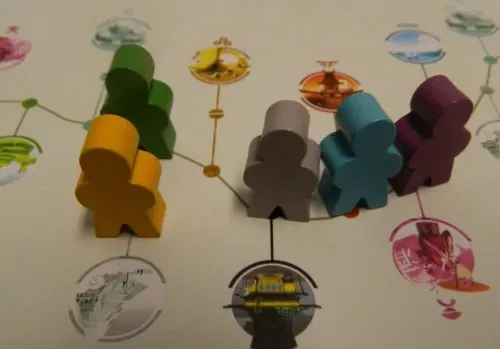
The green and yellow player are on the same space. Since the yellow player is further off the path they will get to move first.
On a player’s turn they can move their playing piece forward as many spaces as they want as long as they don’t pass the next inn space. When moving a player can move to any space that is not currently occupied by another player. If a player moves to a double space and another player is already on the space, they will place their piece on the space that is off the main path. After moving their playing piece the player will take the action associated with the space their piece stopped on.
To keep the current score updated throughout the game, whenever a player scores points they move their marker forward the corresponding number of spaces on the scoring track. If players believe they made a mistake with the scoring during the game, each players’ score can be verified before the final scores are tallied.
Village
A player can only visit a village if they have at least one coin. When a player visits a village they will draw the top three souvenir cards from the draw pile. The player looks at the cards to determine which they would like to purchase. The souvenirs cost the price indicated in the bottom left corner. The player can buy one, two or all three of the cards they drew. All payments are given to the bank.
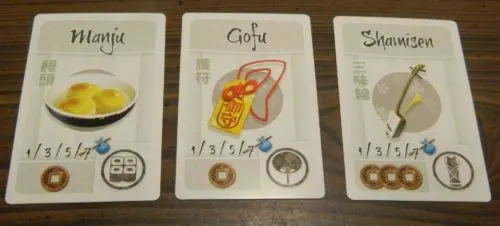
This player drew three souvenir cards. All three cards are from different categories. They would have to pay one coin for the first two items and three coins for the last item.
Players score points from souvenirs by collecting sets of items. All of the souvenir cards are separated into one of four categories: small objects, clothing, art and food/drink. A souvenir’s type is indicated by the symbol in the bottom right corner. When souvenirs are bought they are separated into different sets. Each set of cards can only include one small object, one clothing, one art, and one food/drink. Players will score points based on what item it was in the set. The first item added to a set is worth one point. The second is worth three points. The third is worth five points while the fourth item is worth seven points.
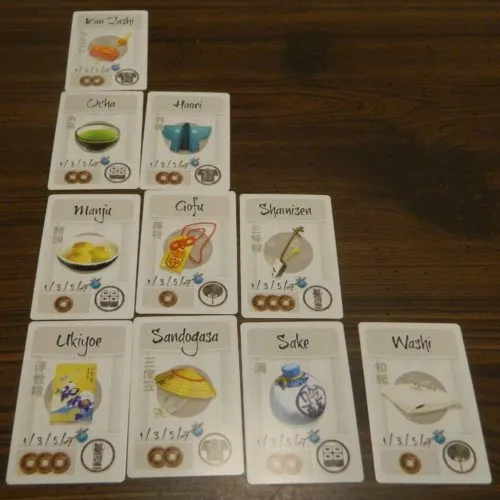
In the first row the player has one card so they will score one point. In the second row the player has two cards so they will score one point for the first card and three points for the second card. For the third row the player will score one point for the first card, three points for the second card, and five points for the third card. For the final row the player will score one point for the first card, three for the second, five for the third, and seven points for the fourth card.
Players can collect several sets of items at the same time.
Farm
For visiting the farm the player will collect three coins from the bank.
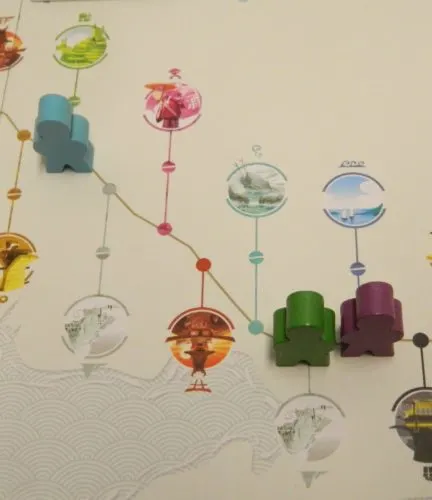
The teal/blue player is on the green panorama space so they will take a green card. The green player is on the white panorama so they will take a white card. The purple player is on the blue panorama so they will take a blue card.
Panorama
There are three different panorama spaces corresponding to the three different panoramas that you can acquire during the game. When a player visits a panorama space they will take the lowest numbered card of that panorama that they don’t currently have. The player will score points corresponding to the number on the card they take.
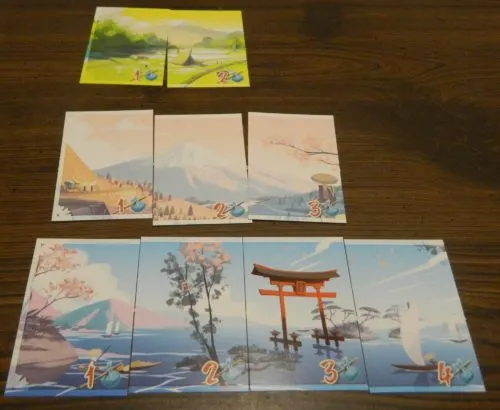
The player has collected the second card from the green panorama so they will score two points. They have collected their third white panorama card so they will score three points. Finally they have collected their fourth blue panorama card so they will score four points.
Once a player completes one of the panoramas they can no longer visit those spaces. The first player to complete each panorama will receive the corresponding achievement card which is worth three points.
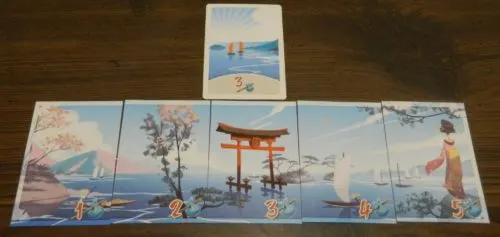
This player was the first to complete the blue panorama so they will receive the appropriate achievement card.
Hot Spring
When you visit the hot spring you will take the top card from the corresponding pile. The player will add this card to their collection and will score victory points (2 or 3) based on the number on the card.
Temple
When a player visits the temple they have the opportunity to donate between one and three coins to the temple. The player places the coin(s) on their section of the temple and will receive one point for each coin they donated.
Encounters
When a player lands on a encounter space they will draw the top card from the corresponding pile and take an action based on what card they draw. The player will keep the card they draw in front of them for the rest of the game.
Shokunin (Traveling Merchant): The player draws the top souvenir card and adds it to their collection. They will score points based on the set that the card is added to.
Annaibito (Guide): The player will take the next card of the panorama shown on the bottom of the card. The player will score the points shown on the card they take. If the player has already completed the panorama shown on the card, they can take the next card from the panorama of their choice.
Samurai: The player scores three points.
Kuge (Noble): The player immediately takes three coins from the bank.
Miko (Shinto Priest): The player takes one coin from the bank and adds it to their spot on the temple. The player scores one point for the donated coin.
Inns
Periodically throughout the game the players will stop at inns. A player cannot skip an inn and must stop when they reach one. When a player reaches an inn they place their traveler piece on the unoccupied space closest to the path. The first player to arrive at the inn draws enough meal cards for all of the players plus one. The first player then looks through the meal cards to see if they would like to purchase one of them. A player does not have to purchase a meal. If a player chooses to purchase a meal they add the card to their collection, pay the bank the coins shown on the card, and then scores six points. The rest of the meal cards are set aside for the next player who arrives at the inn.
There are a couple rules with regards to purchasing meal cards at inns:
- A player can only purchase each type of meal once during their entire journey.
- You can only purchase one meal at each inn.
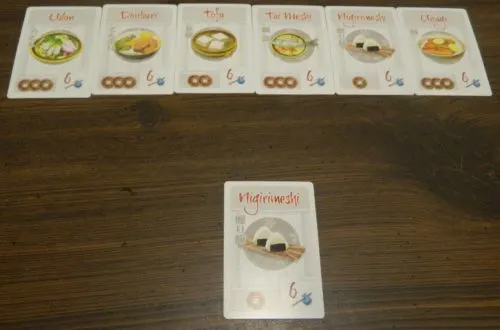
This player arrived at the inn first so they will get first choice from the meal cards. They can purchase any of the meals except for the nigirimeshi as they already purchased it from a previous inn.
After all of the players have arrived at an inn and chose whether to purchase a meal, the next leg of the journey begins. All of the meals that weren’t bought are placed on the bottom of the meal pile. The player who reached the inn last will be the first to leave the inn.
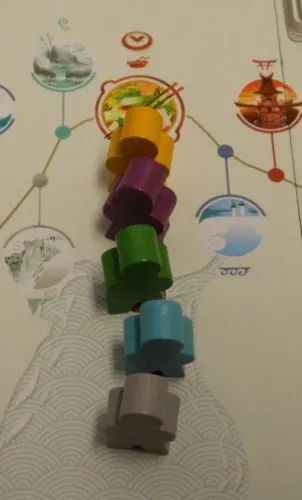
The yellow player was the first player to reach the inn so they will get the first choice from the meal cards. After everyone has had a chance to purchase a meal the players will leave the inn as follows: gray, blue/teal, green, purple, and yellow.
End of Game and Final Scoring
The game ends when all of the players reach the final inn in Edo.
Before calculating each player’s final score, achievement cards are passed out based on players actions throughout their journey. If two or more players tie for any of the achievement cards, both players will score the points.
Gourmet: All of the players count up the coins pictured on their meal cards. The player whose meal cards feature the most coins receives the gourmet achievement card and will score three points.
Bather: The player who collected the most hot spring cards will receive the bather achievement card and will score three points.
Chatterbox: The player who collected the most encounter cards will receive the chatterbox achievement card and will score three points.
Collector: The player who has the most souvenir cards will receive the collector achievement card and will score three points.
Most Generous: Each of the players total up how many coins they gave to the temple. The player who gave the most coins scores ten points. The second most generous player scores seven points. The third most generous player scores four points. All other players that donated at least one coin will score two points. If there is a tie for any of the positions, all of the tied players will score the points for the position.
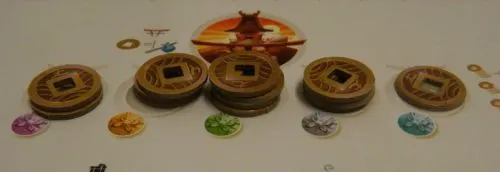
The green player donated the most (four coins) so they will score ten points. The yellow and gray player donated the second most coins (three coins) so they will receive seven points. The pink player donated two coins so they will receive four points. Finally the blue/teal player only donated one coin so they will only receive two points.
After all of the bonus points have been given out, the player with the most points wins the game. If there is a tie for the most points, the tied player with more achievement cards wins the game.
My Thoughts on Tokaido
For people who have never played Tokaido or seen it played before, I will say that it is kind of hard to perfectly describe what type of game it is. While I would probably classify it as a light euro strategy game, I kind of like the description that one of the players came up with while playing the game. He described the game as a roll and move game without the rolling. While this might be a really simplistic way of looking at the game, I actually think it does a pretty good job describing what players do on each turn. Regular readers of Geeky Hobbies that know my feelings towards most roll and move games might think this is meant to be an insult towards Tokaido but it shouldn’t be taken as one.
Basically the main mechanic in Tokaido involves players taking turns choosing where they would like to move their playing piece. There is no need to roll the dice as players can choose what space they want to move to. The only rules regarding movement is that you can’t move backwards, move to a space occupied by other players and you can’t move past an inn until all of the players have arrived. Otherwise you can choose to move to any space you prefer.
While you can pretty much move wherever you want, the movement mechanics play a critical role in the main strategic element of the game. I basically like to think of Tokaido as an opportunity cost game. Instead of managing resources like money/cards/etc the key resource in Tokaido is turns. Each player will have a limited number of turns in the game. Players would gladly visit every space on the board in order to maximize their points but that is not possible. Players have to choose which spaces they really want to visit and which spaces they will have to skip. Which spaces a player chooses to visit will likely determine whether a player wins or loses the game.
As the spaces you visit are critical to your success in the game, turn order becomes crucial. Tokaido takes the decision of turn order a little different than a lot of other games. Usually in games players will usually just take turns in a clockwise fashion. In Tokaido the next player to move is determined by whose playing piece is furthest back on the track. This is a really interesting way to address turn order and I think it serves Tokaido well. In addition to choosing which space is the most beneficial to you, players also have to figure out how each space will impact future turn order. This creates an interesting balance as players don’t want to move too far ahead at any time and lose some turns that could have scored them some additional points. If there is a space that a player really needs to visit though they need to make sure turn order is in their favor or they could end up missing the space.
In most cases players will only move forward a couple spaces on any given turn. This occurs for a couple reasons. The main reason is that players don’t want to end up losing turns that they otherwise could have used to score points. There is no point of jumping right to an inn and skip all of the spaces in between that would score you points. The other reason players don’t want to get too far ahead is that it will lead to the other players getting free turns. If a player falls two or more spaces behind the other players they can take several free turns in a row without messing up the turn order. If you are still going to be the furthest back, there are really no reasons not to move forward just one space as you can score a few points and then immediately take another turn.
I think most of the strategy in Tokaido comes from deciding which space to visit each turn so I appreciate that Tokaido gives players a lot of different ways to score in the game. Having many different ways to score points gives players a lot of choices in the game as you are never locked into a particular strategy until the end of the game. The ways to score points in the game can vary quite a bit as well. Some score you more points up front while others build up the points you earn each time you visit that type of space. These different ways of scoring give players a lot of flexibility as you can change your strategy to fit the current circumstances as well as your own play style.
Players generally have a lot of choices over what strategy to pursue in the game but your character’s special ability is likely going to have some impact on what strategy you should pursue. For the most part I really like the idea of each player getting a character that has a different special ability. These special abilities add some real variety to the game as they gently push you towards a strategy that you otherwise might not have pursued. Generally you want to take advantage of your ability as much as possible as it does give you a distinct advantage over the other players. The characters abilities do add a little luck to the game though. The abilities seem pretty balanced but I still think some are a little better than others. Players could also have a disadvantage at the beginning of the game if they end up choosing a character whose special ability uses the same type of spaces as another player’s character as those two players will likely have to fight over who gets to visit those spaces.
For people who don’t play a lot of designer/hobby board games, Tokaido may at first seem a little overwhelming. The game does have a surprising number of mechanics which means the game takes a little longer to explain than a lot of games. I would say that the game probably takes around 10-15 minutes to explain to new players. At first the game may seem a little overwhelming as there are quite a few things that you have to grasp. For your first couple of turns players may be a little apprehensive about what to do on their turn. Like most well designed games though that feeling subsides pretty quickly. There may be quite a few mechanics in the game but they are all pretty simple. This allows players to learn them fairly quickly. Any reservations you have about the game should be mostly gone around halfway through your first game.
There may be some outliers but I would say that most games of Tokaido are going to be quite close until the very end. Unless a player really does not know what they are doing, most games should end with all of the players within five to ten points of each other. I really like when games do a good job of keeping the game close until the very end as it keeps all of the players invested. If a player knows they have no chance of winning a game, they usually lose interest in the game pretty quickly. Games with close endings stay entertaining throughout as each decision could make the difference between winning or losing.
When most people talk about Tokaido one of the first things that are mentioned is that the game is gorgeous. I didn’t talk about it right away but I totally agree with this assessment. Generally I don’t really talk about much about the artwork/graphics of a board game as I am far from an artist myself but it is hard to deny that Tokaido is a beautiful board game. Tokaido is an elegant game all around. The artwork does a fantastic job of taking you on a relaxing journey through Japan. The component quality is great as well. The only real complaint that I have with the components is that the spaces on the gameboard could have been a little larger as it is hard for some people to see all of the spaces.
In addition to the artwork, the gameplay itself makes for a really relaxing atmosphere. Following with the game’s theme Tokaido really has a strong zen feeling. While Tokaido is a competitive game it doesn’t feel as competitive as most other board games. Usually the players don’t directly compete with each other. The goal in the game is to build the most satisfying journey for your character. Every space you visit in the game will earn you points and other players can’t take points away from you. Even if you ultimately lose the game you can feel proud of yourself if you are able to improve upon your previous high score. Outside of comparing your scores at the end of the game, the only other competitive part of the game is stealing spaces that another player really wanted.
On the topic of stealing spaces from the other players, I would say that this is one of the areas where I had a small issue with Tokaido. I know this had to be implemented into the game or it would basically be a solitary experience where everyone just compared their scores at the end. I don’t really mind the competitiveness either as it keeps the game interesting as you wonder whether another player is going to steal the space that you truly need. The problem that I have with the mechanic is that it introduces a little luck into the game. Each player ultimately chooses which spaces they want to move to but there is some luck involved with what spaces the other players decide to move to. Someone who is really good at reading the other players will have a pretty big advantage in the game. Otherwise you kind of have to hope that luck is on your side and the other players don’t steal the spaces that you really want. This reliance on other players not messing with you makes it feel like you don’t have full control over your fate in the game. With fewer player you will have more control but when you have four or five players it feels like your fate is almost as dependent on the other players than on your own actions.
This is not necessarily a big problem but Tokaido is one of those type of games where an obvious strategy may never present itself. You might be able to develop a pretty good strategy the more you play the game but at least in your first couple of games your strategy will mostly come down to adjusting to your current circumstances. Some people might interpret this as Tokaido not really having any strategy but I don’t really see that as the case. I see Tokaido’s strategy as more of taking what the other players give you as well as controlling the turn order.
My final small complaint that I have with Tokaido is that while the game is 45 minutes long, I honestly wish the game was a little longer. 45 minutes seems like a pretty reasonable length but when you are playing the game it feels like it ends too quickly. I kind of wish the board would have had one or two more sections. The main reason that I wish the game was a little longer is that it would have given player’s strategies a little more time to develop. With how short the journey is, by the time your strategy is really starting to flourish the game is pretty much over. This is not a huge problem but I think Tokaido could have benefited from being around 15 minutes longer.
Should You Buy Tokaido?
If I had to describe Tokaido in one word I would probably use elegant. The amazing artwork takes you right along for the journey through Japan. The laid back nature of the game where everyone can sit back and relax without constantly competing creates a really relaxing experience. The game may be a little intimidating to people at first who don’t play a lot of board games but as the game is so well designed players can pick it up rather quickly. While Tokaido might not be considered a highly strategic game it still presents players with a lot of strategic decisions while still remaining accessible. I like to think of the strategy as an opportunity cost analysis mixed with managing turn order. The game offers players plenty of different ways to score points which allows them to change their strategy on the fly. Tokaido is a great game that I really enjoyed playing. I only had a few issues with the game. At times it feels like luck plays too big of role with your fate being in the hands of the other players as they choose which space to move to. I don’t know if there is an optimal strategy as you mostly have to take what you are given. Finally I think Tokaido could have benefited from being a little longer.
I really enjoyed Tokaido and I would recommend the game to most people. If Tokaido’s gameplay or theme don’t really appeal to you, it probably won’t be for you. If you are looking for a highly strategic game Tokaido might disappoint you as well. If you like games in the light-moderate difficulty level though I think you will really enjoy the game. I can see Tokaido working well as a game to introduce people to more complicated board games. At the end of the day Tokaido is a really relaxing and enjoyable game that I think most people would enjoy playing.
If you would like to purchase Tokaido you can find it online: Amazon, eBay

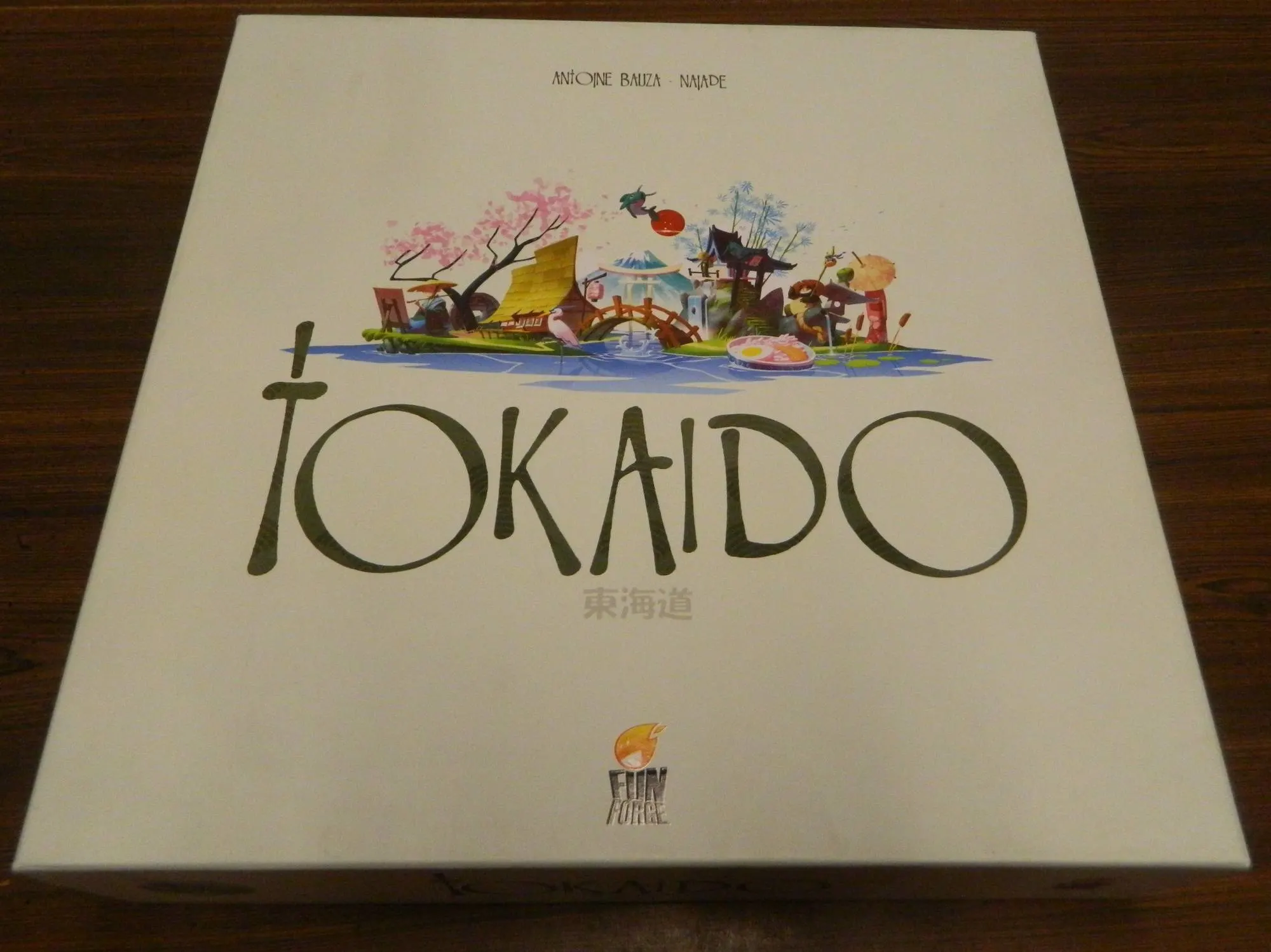
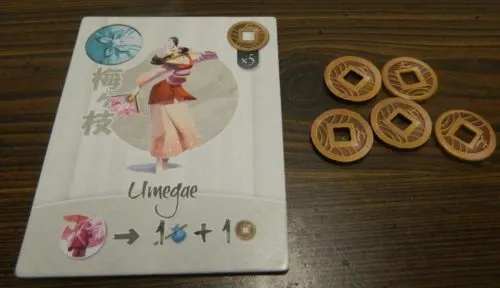
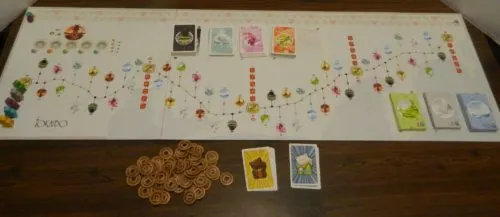
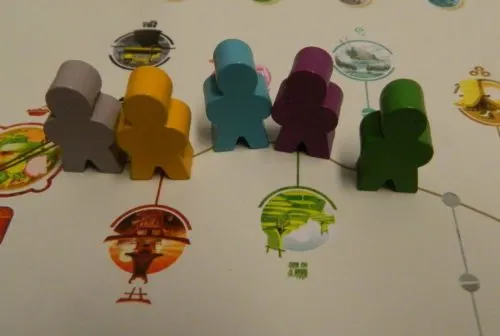
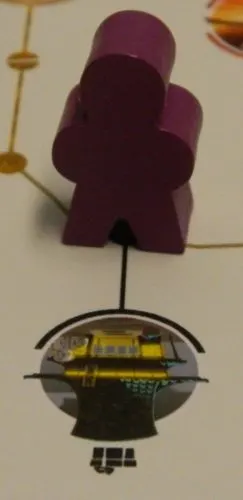
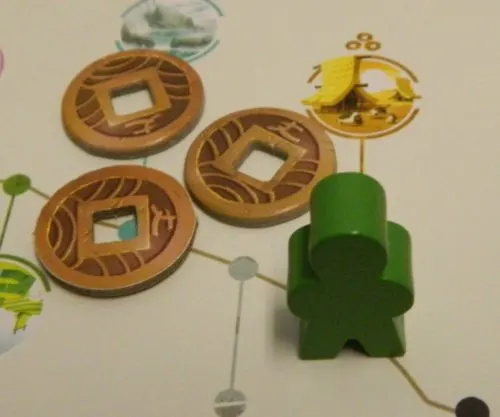
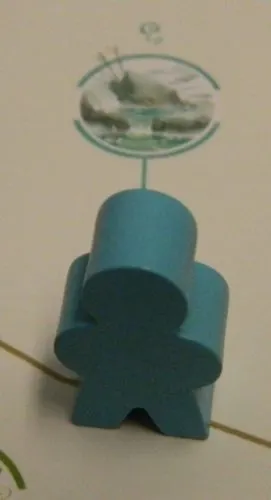
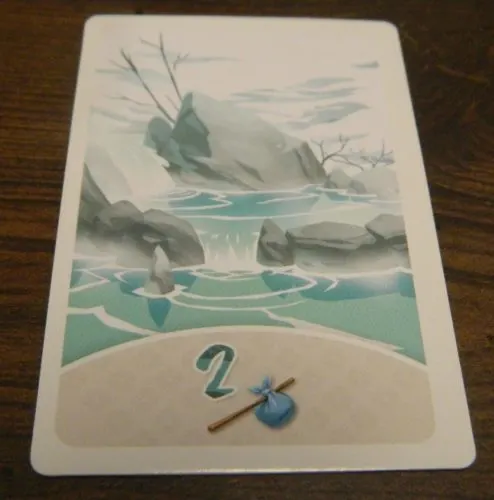
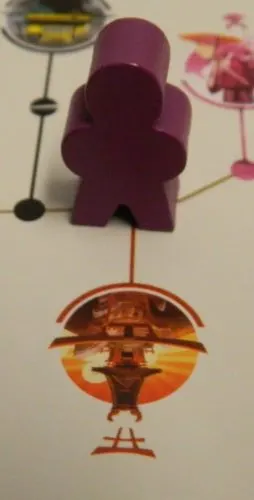
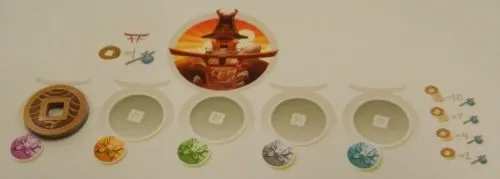
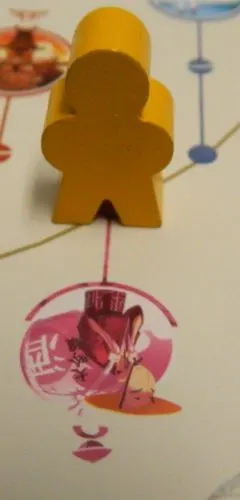
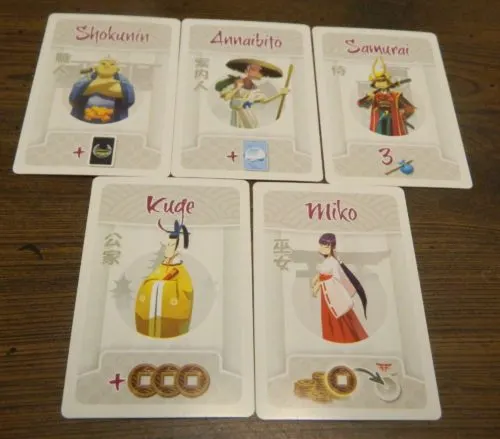
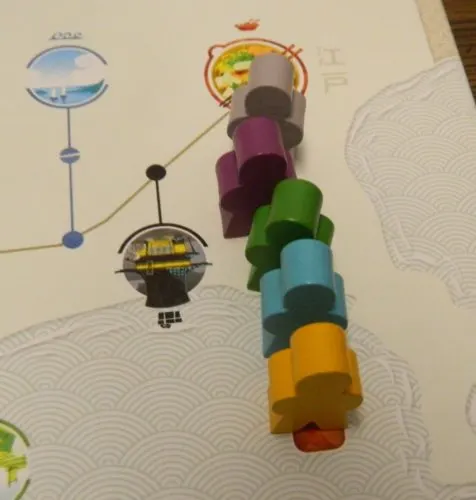
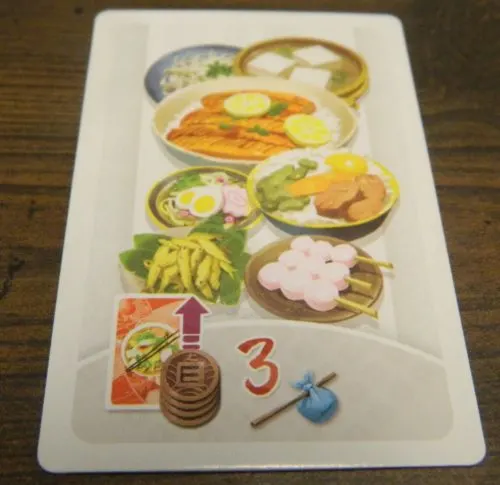
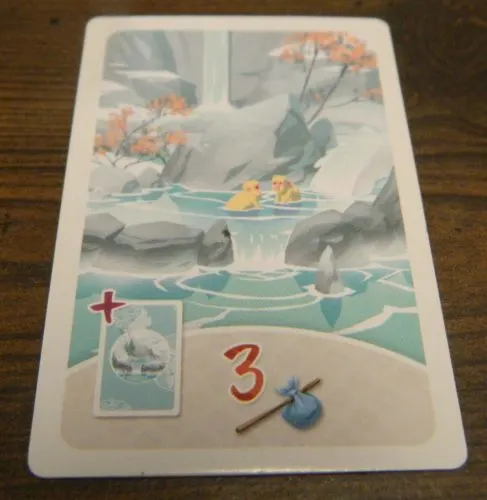
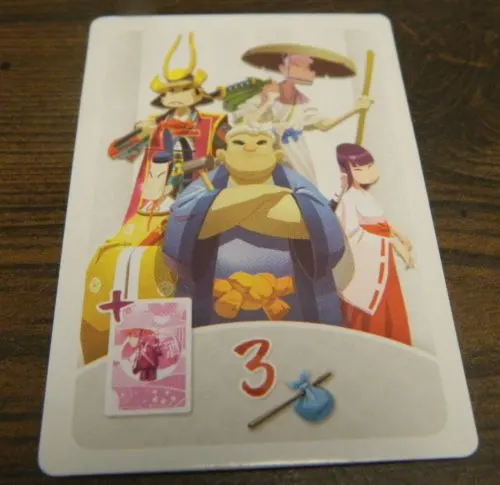
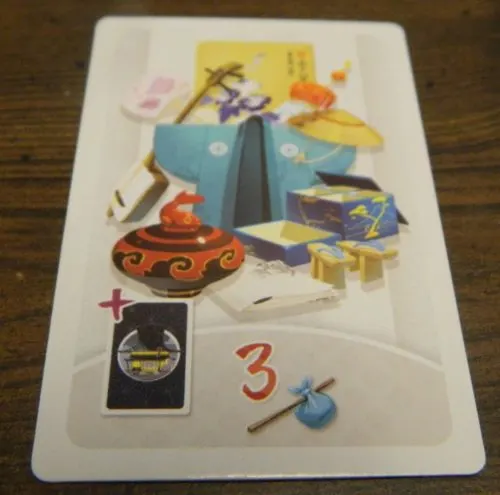
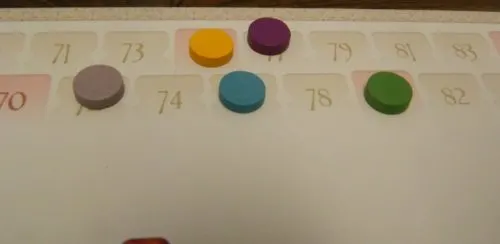
esedege
Wednesday 21st of November 2018
Hi! I can't but agree with you almost to a tee. We luckily don't experience the con you mention about space in the boardgame as we got the Deluxe edition, which comes with a larger board, but I feel you.
Anyway, the main reason for this comment was to tell you that, although I'd too love the game to be longer and to have one or two more sections, the number of stops was set to 55 to fit 'The Fifty three Stations of the Tokaido', a series of woodcut prints by Hiroshige which has 53 stops and two extra prints, one for departure and one for arrival (so it's 55 in total). https://en.wikipedia.org/wiki/The_Fifty-three_Stations_of_the_T%C5%8Dkaid%C5%8D
Eric Mortensen
Saturday 24th of November 2018
I did not know that. That is actually a really interesting tidbit about the game and I can see why the game choose to make the board as long as it did.